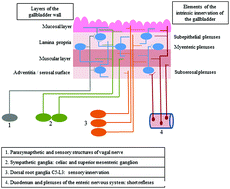当前位置:
X-MOL 学术
›
Toxicol. Res.
›
论文详情
Our official English website, www.x-mol.net, welcomes your feedback! (Note: you will need to create a separate account there.)
Neurochemical characterization of nerve fibers in the porcine gallbladder wall under physiological conditions and after the administration of Salmonella enteritidis lipopolysaccharides (LPS)
Toxicology Research ( IF 2.1 ) Pub Date : 2017-10-26 00:00:00 , DOI: 10.1039/c7tx00211d Krystyna Makowska 1, 2, 3 , Anita Mikolajczyk 3, 4, 5, 6 , Jaroslaw Calka 1, 2, 3 , Slawomir Gonkowski 1, 2, 3
Toxicology Research ( IF 2.1 ) Pub Date : 2017-10-26 00:00:00 , DOI: 10.1039/c7tx00211d Krystyna Makowska 1, 2, 3 , Anita Mikolajczyk 3, 4, 5, 6 , Jaroslaw Calka 1, 2, 3 , Slawomir Gonkowski 1, 2, 3
Affiliation

|
Lipopolysaccharides (LPS, bacterial endotoxin) are a component of the cellular membrane of Gram-negative bacteria, which is known as an important pathological factor. In spite of many previous studies describing multidirectional negative effects of LPS on living organisms, the knowledge concerning the influence of bacterial endotoxins on the gallbladder innervation is extremely scarce. The present study, based on the immunofluorescence technique, describes the changes in the neurochemical characterization of nerves within various parts of the porcine gallbladder (neck, body and fundus) after the administration of low doses of LPS. The obtained results show that even low doses of bacterial endotoxins affect the nerve structures within the gallbladder wall and the intensity of fluctuations in immunoreactivity to particular substances clearly depends on the part of the investigated organ. The most evident changes were observed in the case of fibers exhibiting the presence of neuropeptide Y (an increase from 7.84 ± 0.17 to 14.66 ± 0.37) in the neck, substance P (an increase from 0.88 ± 0.1 to 8.4 ± 0.3) in the body and the vesicular acetylocholine transporter in the gallbladder's fundus (an increase from 4.29 ± 0.18 to 11.01 ± 0.26). The mechanisms of the observed changes still remain unclear, but probably they are connected with the pro-inflammatory and/or neurodegenerative activity of LPS.
中文翻译:

生理条件下和肠炎沙门氏菌脂多糖(LPS)给药后猪胆囊壁中神经纤维的神经化学特征
脂多糖(LPS,细菌内毒素)是革兰氏阴性细菌细胞膜的组成部分,被称为重要的病理因素。尽管先前有许多研究描述了LPS对活生物体的多方向负面影响,但是关于细菌内毒素对胆囊神经支配的影响的知识仍然非常匮乏。本研究基于免疫荧光技术,描述了低剂量LPS给药后猪胆囊各个部位(颈部,身体和眼底)神经神经化学特性的变化。获得的结果表明,即使低剂量的细菌内毒素也会影响胆囊壁内的神经结构,并且对特定物质的免疫反应性波动的强度显然取决于所研究器官的部位。观察到最明显的变化是,纤维在脖子上存在神经肽Y(从7.84±0.17增加到14.66±0.37),而体内P物质(从0.88±0.1增加到8.4±0.3)胆囊底部的囊泡乙酰胆碱转运蛋白(从4.29±0.18增加到11.01±0.26)。观察到的变化的机制仍然不清楚,但可能与LPS的促炎和/或神经退行性活动有关。观察到最明显的变化是,纤维在脖子上存在神经肽Y(从7.84±0.17增加到14.66±0.37),而体内P物质(从0.88±0.1增加到8.4±0.3)胆囊底部的囊泡乙酰胆碱转运蛋白(从4.29±0.18增加到11.01±0.26)。观察到的变化的机制仍然不清楚,但可能与LPS的促炎和/或神经退行性活动有关。观察到最明显的变化是,纤维在脖子上存在神经肽Y(从7.84±0.17增加到14.66±0.37),而体内P物质(从0.88±0.1增加到8.4±0.3)胆囊底部的囊泡乙酰胆碱转运蛋白(从4.29±0.18增加到11.01±0.26)。观察到的变化的机制仍然不清楚,但可能与LPS的促炎和/或神经退行性活动有关。
更新日期:2017-11-23
中文翻译:

生理条件下和肠炎沙门氏菌脂多糖(LPS)给药后猪胆囊壁中神经纤维的神经化学特征
脂多糖(LPS,细菌内毒素)是革兰氏阴性细菌细胞膜的组成部分,被称为重要的病理因素。尽管先前有许多研究描述了LPS对活生物体的多方向负面影响,但是关于细菌内毒素对胆囊神经支配的影响的知识仍然非常匮乏。本研究基于免疫荧光技术,描述了低剂量LPS给药后猪胆囊各个部位(颈部,身体和眼底)神经神经化学特性的变化。获得的结果表明,即使低剂量的细菌内毒素也会影响胆囊壁内的神经结构,并且对特定物质的免疫反应性波动的强度显然取决于所研究器官的部位。观察到最明显的变化是,纤维在脖子上存在神经肽Y(从7.84±0.17增加到14.66±0.37),而体内P物质(从0.88±0.1增加到8.4±0.3)胆囊底部的囊泡乙酰胆碱转运蛋白(从4.29±0.18增加到11.01±0.26)。观察到的变化的机制仍然不清楚,但可能与LPS的促炎和/或神经退行性活动有关。观察到最明显的变化是,纤维在脖子上存在神经肽Y(从7.84±0.17增加到14.66±0.37),而体内P物质(从0.88±0.1增加到8.4±0.3)胆囊底部的囊泡乙酰胆碱转运蛋白(从4.29±0.18增加到11.01±0.26)。观察到的变化的机制仍然不清楚,但可能与LPS的促炎和/或神经退行性活动有关。观察到最明显的变化是,纤维在脖子上存在神经肽Y(从7.84±0.17增加到14.66±0.37),而体内P物质(从0.88±0.1增加到8.4±0.3)胆囊底部的囊泡乙酰胆碱转运蛋白(从4.29±0.18增加到11.01±0.26)。观察到的变化的机制仍然不清楚,但可能与LPS的促炎和/或神经退行性活动有关。



























 京公网安备 11010802027423号
京公网安备 11010802027423号